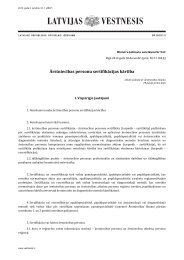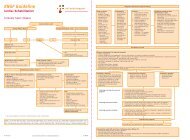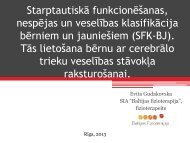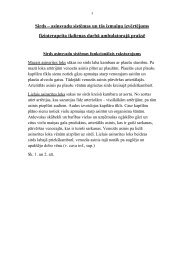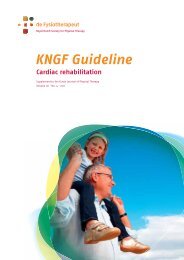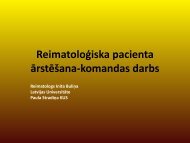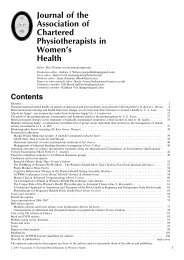You also want an ePaper? Increase the reach of your titles
YUMPU automatically turns print PDFs into web optimized ePapers that Google loves.
<strong>Low</strong> <strong>Back</strong> <strong>Pain</strong>: Clinical Practice Guidelines<br />
ICF-Based Category<br />
(With ICD-10 Associations) Symptoms Impairments of Body Function Primary Intervention Strategies<br />
Chronic <strong>Low</strong> <strong>Back</strong> <strong>Pain</strong> with<br />
Movement Coordination<br />
Impairments<br />
Spinal instabilities<br />
Acute <strong>Low</strong> <strong>Back</strong> <strong>Pain</strong> with<br />
Related (Referred) <strong>Low</strong>er<br />
Extremity <strong>Pain</strong><br />
Flatback syndrome<br />
Lumbago due to displacement<br />
of intervertebral disc<br />
Acute <strong>Low</strong> <strong>Back</strong> <strong>Pain</strong> with<br />
Radiating <strong>Pain</strong><br />
Lumbago with sciatica<br />
Subacute <strong>Low</strong> <strong>Back</strong> <strong>Pain</strong> with<br />
Radiating <strong>Pain</strong><br />
Lumbago with sciatica<br />
• Chronic, recurring low back pain<br />
and associated (referred) lower<br />
extremity pain<br />
• Acute low back pain that is com-<br />
monly associated with referred<br />
buttock, thigh, or leg pain<br />
• Symptoms are often worsened<br />
with flexion activities and sitting<br />
• Acute low back pain with associ-<br />
ated radiating (narrow band of<br />
lancinating) pain in the involved<br />
lower extremity<br />
• <strong>Low</strong>er extremity paresthesias,<br />
numbness, and weakness may<br />
be reported<br />
• Subacute, recurring, mid-back<br />
and/or low back pain with associ-<br />
ated radiating pain in the involved<br />
lower extremity<br />
• <strong>Low</strong>er extremity paresthesias,<br />
numbness, and weakness may<br />
be reported<br />
Presence of 1 or more of the following:<br />
• <strong>Low</strong> back and/or low back–related lower<br />
extremity pain that worsens with sustained<br />
end-range movements or positions<br />
• Lumbar hypermobility with segmental motion<br />
assessment<br />
• Mobility deficits of the thorax and lumbopel-<br />
vic/hip regions<br />
• Diminished trunk or pelvic-region muscle<br />
strength and endurance<br />
• Movement coordination impairments while<br />
performing community/work-related recre-<br />
ational or occupational activities<br />
• <strong>Low</strong> back and lower extremity pain that can<br />
be centralized and diminished with specific<br />
postures and/or repeated movements<br />
• Reduced lumbar lordosis<br />
• Limited lumbar extension mobility<br />
• Lateral trunk shift may be present<br />
• Clinical findings consistent with subacute or<br />
chronic low back pain with movement coor-<br />
dination impairments classification criteria<br />
• <strong>Low</strong>er extremity radicular symptoms that<br />
are present at rest or produced with initial to<br />
mid-range spinal mobility, lower-limb tension<br />
tests/straight leg raising, and/or slump tests<br />
• Signs of nerve root involvement may be<br />
present<br />
It is common for the symptoms and impair-<br />
ments of body function in patients who have<br />
acute low back pain with radiating pain to also<br />
be present in patients who have acute low back<br />
pain with related (referred) lower extremity<br />
a42 | april 2012 | volume 42 | number 4 | journal of orthopaedic & sports physical therapy<br />
pain<br />
• Mid-back, low back, and back-related radiat-<br />
ing pain or paresthesia that are reproduced<br />
with mid-range and worsen with end range:<br />
1. <strong>Low</strong>er limb tension testing/straight leg<br />
raising tests, and/or...<br />
2. Slump tests<br />
• May have lower extremity sensory, strength,<br />
or reflex deficits associated with the involved<br />
nerve(s)<br />
• Neuromuscular re-education to provide<br />
dynamic (muscular) stability to main-<br />
tain the involved lumbosacral structures<br />
in less symptomatic, mid-range posi-<br />
tions during household, occupational,<br />
or recreational activities<br />
• Manual therapy procedures and thera-<br />
peutic exercises to address identified<br />
thoracic spine, ribs, lumbopelvic, or hip<br />
mobility deficits<br />
• Therapeutic (strengthening) exercises to<br />
address trunk and pelvic-region muscle<br />
strength and endurance deficits<br />
• Community/work reintegration training<br />
in pain management strategies while<br />
returning to community/work activities<br />
• Therapeutic exercises, manual therapy,<br />
or traction procedures that promote<br />
centralization and improve lumbar<br />
extension mobility<br />
• Patient education in positions that<br />
promote centralization<br />
• Progress to interventions consistent<br />
with the Subacute or Chronic <strong>Low</strong> <strong>Back</strong><br />
<strong>Pain</strong> with Movement Coordination<br />
Impairments intervention strategies<br />
• Patient education in positions that<br />
reduce strain or compression to the<br />
involved nerve root(s) or nerves<br />
• Manual or mechanical traction<br />
• Manual therapy to mobilize the articula-<br />
tions and soft tissues adjacent to the<br />
involved nerve root(s) or nerves that<br />
exhibit mobility deficits<br />
• Nerve mobility exercises in the pain-<br />
free, non–symptom-producing ranges to<br />
improve the mobility of central (dural)<br />
and peripheral neural elements<br />
• Manual therapy to mobilize the articula-<br />
tions and soft tissues adjacent to the<br />
involved nerve root(s) or nerves that<br />
exhibit mobility deficits<br />
• Manual or mechanical traction<br />
• Nerve mobility and slump exercises in<br />
the mid- to end ranges to improve the<br />
mobility of central (dural) and periph-<br />
eral neural elements<br />
(continued)



